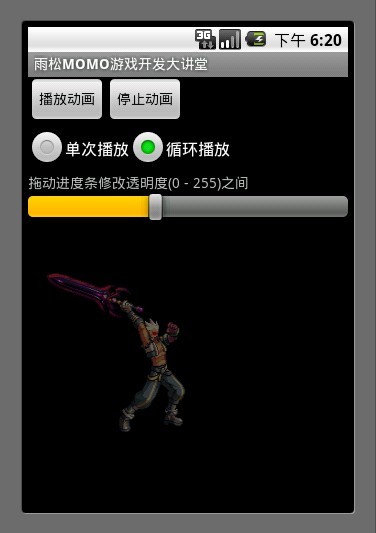Android游戏开发之使用AnimationDrable实现Frame动画(三十一)
2011-09-04 02:37
1041 查看
[align=center]Android游戏开发之使用AnimationDrable实现Frame动画
[b]雨松MOMO原创文章如转载,请注明:转载至我的独立域名博客雨松MOMO程序研究院,原文地址:http://www.xuanyusong.com/archives/355[/b]
[/align]

Android开发中在制作2D帧动画中提供了使用XML配置动画文件的方式绘制,也就是说Android底层提供了动画播放的接口,那么我们分析一下如何调用它的接口来绘制动画。首先在工程res资源文件夹下创建anim动画文件夹,在这个文件夹中建立一个animation.xml文件, 这样它的路径就为re/anim/animation.xml。
看看内容应该是很好理解的,<animation-list>为动画的总标签,这里面放着帧动画 <item>标签,也就是说若干<item>标签的帧 组合在一起就是帧动画了。<animation-list > 标签中android:oneshot="false" 这是一个非常重要的属性,默认为false 表示 动画循环播放, 如果这里写true 则表示动画只播发一次。 <item>标签中记录着每一帧的信息android:drawable="@drawable/a"表示这一帧用的图片为"a",下面以此类推。 android:duration="100" 表示这一帧持续100毫秒,可以根据这个值来调节动画播放的速度。
下面这个例子的内容为 播放动画 与关闭动画 、设置播放类型 单次还是循环、拖动进度条修改动画的透明度,废话不多说直接进正题~~

这是一个比较简单的布局文件,应该都能看懂吧。 我主要说一下 最后的这个 ImageView, 它就是用来显示我们的动画。 这里使用android:background="@anim/animation"设置这个ImageView现实的背景为一个动画,动画资源的路径为res/anim/animation.xml ,当然 设置background同样也可以在代码中设置。
通过getBackground方法就可以拿到这个animationDrawable对象。
AnimationDrawable 就是用来控制这个帧动画,这个类中提供了很多方法。
animationDrawable.start(); 开始这个动画
animationDrawable.stop(); 结束这个动画
animationDrawable.setAlpha(100);设置动画的透明度, 取值范围(0 - 255)
animationDrawable.setOneShot(true); 设置单次播放
animationDrawable.setOneShot(false); 设置循环播放
animationDrawable.isRunning(); 判断动画是否正在播放
animationDrawable.getNumberOfFrames(); 得到动画的帧数。
将这个例子的完整代码贴上
拖动进度条设置Alpha值的时候 一定要使用 imageView.postInvalidate(); 方法来通知UI线程重绘屏幕中的imageView 否则会看不到透明的效果 。这里切记切记~~

[align=left]
今天周末了,忙碌了一周终于可以休息休息了。最近经朋友介绍MOMO也玩起了新浪微博 哇咔咔~~,[b]我的微薄地址在左侧的个人说明中 , 希望大家都可以来关注我喔。[/b]
总的来说这章内容还是比较简单的。老规矩每篇文章都会附带源代码,最后如果你还是觉得我写的不够详细 看的不够爽 不要紧我把源代码的下载地址贴出来 欢迎大家一起讨论学习雨松MOMO希望可以和大家一起进步。
下载地址:http://download.csdn.net/source/3573219
[/align]
[b]雨松MOMO原创文章如转载,请注明:转载至我的独立域名博客雨松MOMO程序研究院,原文地址:http://www.xuanyusong.com/archives/355[/b]
[/align]

Android开发中在制作2D帧动画中提供了使用XML配置动画文件的方式绘制,也就是说Android底层提供了动画播放的接口,那么我们分析一下如何调用它的接口来绘制动画。首先在工程res资源文件夹下创建anim动画文件夹,在这个文件夹中建立一个animation.xml文件, 这样它的路径就为re/anim/animation.xml。
看看内容应该是很好理解的,<animation-list>为动画的总标签,这里面放着帧动画 <item>标签,也就是说若干<item>标签的帧 组合在一起就是帧动画了。<animation-list > 标签中android:oneshot="false" 这是一个非常重要的属性,默认为false 表示 动画循环播放, 如果这里写true 则表示动画只播发一次。 <item>标签中记录着每一帧的信息android:drawable="@drawable/a"表示这一帧用的图片为"a",下面以此类推。 android:duration="100" 表示这一帧持续100毫秒,可以根据这个值来调节动画播放的速度。
<animation-list xmlns:android="http://schemas.android.com/apk/res/android" android:oneshot="false"> <item android:drawable="@drawable/a" android:duration="100" /> <item android:drawable="@drawable/b" android:duration="100" /> <item android:drawable="@drawable/c" android:duration="100" /> <item android:drawable="@drawable/d" android:duration="100" /> <item android:drawable="@drawable/e" android:duration="100" /> <item android:drawable="@drawable/f" android:duration="100" /> <item android:drawable="@drawable/g" android:duration="100" /> <item android:drawable="@drawable/h" android:duration="100" /> <item android:drawable="@drawable/i" android:duration="100" /> <item android:drawable="@drawable/j" android:duration="100" /> </animation-list>
下面这个例子的内容为 播放动画 与关闭动画 、设置播放类型 单次还是循环、拖动进度条修改动画的透明度,废话不多说直接进正题~~

<?xml version="1.0" encoding="utf-8"?> <LinearLayout xmlns:android="http://schemas.android.com/apk/res/android" android:orientation="vertical" android:layout_width="fill_parent" android:layout_height="fill_parent" > <LinearLayout android:orientation="horizontal" android:layout_width="wrap_content" android:layout_height="wrap_content" > <Button android:id="@+id/button0" android:layout_width="wrap_content" android:layout_height="wrap_content" android:text="播放动画" /> <Button android:id="@+id/button1" android:layout_width="wrap_content" android:layout_height="wrap_content" android:text="停止动画" /> </LinearLayout> <RadioGroup android:id="@+id/radiogroup" android:layout_width="wrap_content" android:layout_height="wrap_content" android:orientation="horizontal"> <RadioButton android:id="@+id/checkbox0" android:layout_width="wrap_content" android:layout_height="wrap_content" android:checked="true" android:text="单次播放" /> <RadioButton android:id="@+id/checkbox1" android:layout_width="wrap_content" android:layout_height="wrap_content" android:text="循环播放" /> </RadioGroup> <TextView android:layout_width="wrap_content" android:layout_height="wrap_content" android:text="拖动进度条修改透明度(0 - 255)之间" /> <SeekBar android:id="@+id/seekBar" android:layout_width="fill_parent" android:layout_height="wrap_content" android:max="256" android:progress="256"/> <ImageView android:id="@+id/imageView" android:background="@anim/animation" android:layout_width="wrap_content" android:layout_height="wrap_content" /> </LinearLayout>
这是一个比较简单的布局文件,应该都能看懂吧。 我主要说一下 最后的这个 ImageView, 它就是用来显示我们的动画。 这里使用android:background="@anim/animation"设置这个ImageView现实的背景为一个动画,动画资源的路径为res/anim/animation.xml ,当然 设置background同样也可以在代码中设置。
imageView.setBackgroundResource(R.anim.animation);
通过getBackground方法就可以拿到这个animationDrawable对象。
/**拿到ImageView对象**/ imageView = (ImageView)findViewById(R.id.imageView); /**通过ImageView对象拿到背景显示的AnimationDrawable**/ animationDrawable = (AnimationDrawable) imageView.getBackground();
AnimationDrawable 就是用来控制这个帧动画,这个类中提供了很多方法。
animationDrawable.start(); 开始这个动画
animationDrawable.stop(); 结束这个动画
animationDrawable.setAlpha(100);设置动画的透明度, 取值范围(0 - 255)
animationDrawable.setOneShot(true); 设置单次播放
animationDrawable.setOneShot(false); 设置循环播放
animationDrawable.isRunning(); 判断动画是否正在播放
animationDrawable.getNumberOfFrames(); 得到动画的帧数。
将这个例子的完整代码贴上
import android.app.Activity;
import android.graphics.drawable.AnimationDrawable;
import android.os.Bundle;
import android.util.Log;
import android.view.View;
import android.view.View.OnClickListener;
import android.widget.Button;
import android.widget.ImageView;
import android.widget.RadioButton;
import android.widget.RadioGroup;
import android.widget.SeekBar;
import android.widget.SeekBar.OnSeekBarChangeListener;
public class SimpleActivity extends Activity {
/**播放动画按钮**/
Button button0 = null;
/**停止动画按钮**/
Button button1 = null;
/**设置动画循环选择框**/
RadioButton radioButton0= null;
RadioButton radioButton1= null;
RadioGroup radioGroup = null;
/**拖动图片修改Alpha值**/
SeekBar seekbar = null;
/**绘制动画View**/
ImageView imageView = null;
/**绘制动画对象**/
AnimationDrawable animationDrawable = null;
@Override
public void onCreate(Bundle savedInstanceState) {
super.onCreate(savedInstanceState);
setContentView(R.layout.simple);
/**拿到ImageView对象**/
imageView = (ImageView)findViewById(R.id.imageView);
/**通过ImageView对象拿到背景显示的AnimationDrawable**/
animationDrawable = (AnimationDrawable) imageView.getBackground();
/**开始播放动画**/
button0 = (Button)findViewById(R.id.button0);
button0.setOnClickListener(new OnClickListener() {
@Override
public void onClick(View arg0) {
/**播放动画**/
if(!animationDrawable.isRunning()) {
animationDrawable.start();
}
}
});
/**停止播放动画**/
button1 = (Button)findViewById(R.id.button1);
button1.setOnClickListener(new OnClickListener() {
@Override
public void onClick(View arg0) {
/**停止动画**/
if(animationDrawable.isRunning()) {
animationDrawable.stop();
}
}
});
/**单次播放**/
radioButton0 = (RadioButton)findViewById(R.id.checkbox0);
/**循环播放**/
radioButton1 = (RadioButton)findViewById(R.id.checkbox1);
/**单选列表组**/
radioGroup = (RadioGroup)findViewById(R.id.radiogroup);
radioGroup.setOnCheckedChangeListener(new RadioGroup.OnCheckedChangeListener() {
@Override
public void onCheckedChanged(RadioGroup radioGroup, int checkID) {
if(checkID == radioButton0.getId()) {
//设置单次播放
animationDrawable.setOneShot(true);
}else if (checkID == radioButton1.getId()) {
//设置循环播放
animationDrawable.setOneShot(false);
}
//发生改变后让动画重新播放
animationDrawable.stop();
animationDrawable.start();
}
});
/**监听的进度条修改透明度**/
seekbar = (SeekBar)findViewById(R.id.seekBar);
seekbar.setOnSeekBarChangeListener(new OnSeekBarChangeListener() {
@Override
public void onStopTrackingTouch(SeekBar seekBar) {
}
@Override
public void onStartTrackingTouch(SeekBar seekBar) {
}
@Override
public void onProgressChanged(SeekBar seekBar, int progress, boolean frameTouch) {
/**设置动画Alpha值**/
animationDrawable.setAlpha(progress);
/**通知imageView 刷新屏幕**/
imageView.postInvalidate();
}
});
}
}拖动进度条设置Alpha值的时候 一定要使用 imageView.postInvalidate(); 方法来通知UI线程重绘屏幕中的imageView 否则会看不到透明的效果 。这里切记切记~~

[align=left]
今天周末了,忙碌了一周终于可以休息休息了。最近经朋友介绍MOMO也玩起了新浪微博 哇咔咔~~,[b]我的微薄地址在左侧的个人说明中 , 希望大家都可以来关注我喔。[/b]
总的来说这章内容还是比较简单的。老规矩每篇文章都会附带源代码,最后如果你还是觉得我写的不够详细 看的不够爽 不要紧我把源代码的下载地址贴出来 欢迎大家一起讨论学习雨松MOMO希望可以和大家一起进步。
下载地址:http://download.csdn.net/source/3573219
[/align]
相关文章推荐
- Android游戏开发之使用AnimationDrable实现Frame动画(三十一)
- Android游戏开发之使用AnimationDrable实现Frame动画
- android游戏开发框架libgdx的使用(二十三)—使用Universal Tween Engine实现动画效果
- Android UI开发第四十三篇——使用Property Animation实现墨迹天气3.0引导界面及动画实现
- 【Android游戏开发二十二】(图文详解)游戏中灵活实现动画播放!简述J2me的游戏类库与Android游戏开发!
- (图文详解)游戏中灵活实现动画播放!简述J2me的游戏类库与Android游戏开发!
- 【Android游戏开发二十二】(图文详解)游戏中灵活实现动画播放!简述J2me的游戏类库与Android游戏开发!
- 22—(图文详解)游戏中灵活实现动画播放!简述J2me的游戏类库与Android游戏开发
- Android游戏开发之Tween动画的实现(三十二)
- 【Android游戏开发二十二】(图文详解)游戏中灵活实现动画播放!简述J2me的游戏类库与Android游戏开发!
- Android游戏开发之Tween动画的实现(三十二)
- Android游戏开发学习笔记(一):tweened animation自定义动画的实现
- Android开发之Frame动画实现方法
- Android应用程序入门 推箱子游戏开发(一) surfaceView 实现动画效果
- 【Android2D游戏开发十四】(未完待续)手把手教你在SurfaceView中照样使用Android 动画—Tween Animation!
- (转)【Android游戏开发二十二】(图文详解)游戏中灵活实现动画播放!简述J2me的游戏类库与Android游戏开发!
- Android游戏开发之Tween动画的实现
- 【Android LibGDX游戏引擎开发教程】第09期:动画类的使用
- android游戏开发框架libgdx的使用(十八)—简单的AVG游戏效果实现
- 【Android游戏开发二十二】(图文详解)游戏中灵活实现动画播放!简述J2me的游戏类库与Android游戏开发!
